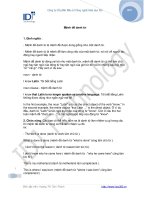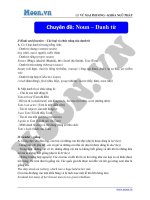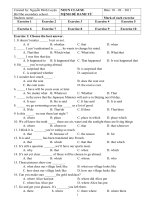Mệnh đề danh từ nounnoun clauses
Bạn đang xem bản rút gọn của tài liệu. Xem và tải ngay bản đầy đủ của tài liệu tại đây (3.53 MB, 22 trang )
CHAPTER 9
NOUNS AND NOUN CLAUSE IN
THE ENGLISH LANGUAGE
1. Definition
A noun is a part of the speech which includes
words refering to the name of
A
person: Tom, Amy, John.ect
A place: NewYork, London, Japan.ect
A occupation or job title: student, teacher,
worker
A quality: anger, discourage, kindness.ect
An action: reading, talking, writting.ect
Noun can function in a sentences as
Subject: The childrent phay the piano
1
Object: He gave Mary a book
2
3
4
5
Complement: She is a teacher
Attribute: The student’s pen is in the table
Part of adverbial modifier: He is running in the yard
6
In apposition. Eg: Mr Tom, the doctor, a brother
7
8
9
When we speak directly to sb. Eg: Tom, open the
window, will you?
The articles or determiners. Eg: a pen, the book,
the desk
The prepositions: Eg: In the table, for a long time
2. Classification
1. The concrete nouns
Eg: Apple, cat, flower, famer
2. The abstract nouns
Eg: Belief, love, pride, book, pen
3. The proper nouns
Eg: London, New Yorker, The French,
John
4. The common nouns
Eg: car, dog, book, pen, desk
5. The collective nouns
Eg: audience, flock, group, family
6. The material nouns
Eg: Silk, wood, sand, rock
7. The countable nouns
Eg: Pencial/ pencials, apple/ apples,
desk, clock
8. The uncountable nouns
Eg: Milk, water, music, snow
9. The one word
Eg: cat, dog, mokey, ship
10. The compound nouns
Eg: Cupbroad, textbook, snowball,
seafood
3. FORMATION
Made by 4 majors
1. The conversion: is a change in the function of the
word without any reduction
Eg: - accecess, bottle, can, closet, email, fool,
name,ship...(v&n)
- large, empty,... (adj & n)
- butter, nail, attack alert...(n&v)
2.The derived nouns: are formed by adding
affixes
1. Adj + ness
Eg: kindness, sadness, laziness, fondness
2. Adj + dom
Eg: kingdom, wisdom, dukedom...
3. Adj + th
Eg: Length, warmth, strength
4. Adj + ty
Eg: Safety, cruelty, honesty
5. Adj + ism
Eg: socialism, heroism, alcoholism
6. Adj + ist
Eg: socialist, rightist, nationalist
7. Noun + hood
Eg: childhood, boyhood, motherhood
8. Noun + ship
Eg: friendship, memebership
9. Verb + tion
Eg: production, protection, quotation
10. Verb + ment
Eg: development, argument, investment
10. Verb+ ing
Eg: walking, reading, talking, writting
11. Verb+ er
Eg: laughter, player, visitor
12. Noun +er
Eg: New Yorker, footballer
3. Compound nouns: are made by two or
more free morphemes together
1. N+ N
Eg: board game, action movie, beauty shop
2. Adj + N
Eg: weak point, tight schedule, steady job
3. V + N
Eg: washing machine, swimming pool
4. Gerund + N
Eg: drawing-room, looking-glass, writingdesk
5: N+ gerund
Eg: sight-seeing, horse-riding
6. Adv + V
Eg: Income, output, outcome
7. V + Adv
Eg: drawback, Lock-up, send-off
8. Preposition/ adv+ N
Eg: overcoat, downfall, afterthought
9. Present participale+
N
Eg: runnig water, crying child
4. The shortened nouns: are made by
cutting short the original nouns
Eg: flu, smog, brunch....
4. Gender
• In english, noun are categorized as masculine,
feminine or neuter
• The gender of a noun affects the pronouns we use
with it ( eg: he, she, it) and the possessve
determiners ( eg: his, her, its)
• The difference between male and female can be
made by 2 ways:
By 2 different words:
Eg: boy-girl, man-woman, husband-wife
By morphemes combination:
Eg: actor-actress, host- hostess, water –
wateress, lion- lioness
boyfriend – girlfriend, manservant –
maidservant, bull calf – cow calf
• Gender- neutral nouns for people
Eg: parent, teacher, doctor, worker, farmer
• In literature, the nouns denoting strength or
terrible concept are considered as male:
Eg; day, war, death, the sun
• The nouns showing beautiful, acttractive concept
are considered as female
Eg: night , the moon, freedom, peace, spring
5. Number
There are 2 numbers in noun- number: singular
and plural
1. Singular form
Indicates one thing
Both the countable nouns and the uncountable
nouns have the singular form
Eg: a pen, a book, a dog, money, water, oil
2. The plural form
Indicates more than one person and one thing
It is expressed by a countable nouns added with a
bound morpheme expressing plural
Eg: books, pens, movies..
Ways to form plural from singular
1. By suffixing “s” to the singular-noun
Eg: joy- joys, run- runs, chair- chairs, radio- radios
2. By suffixing “es” to the singular form ending (ch, sh, s,
ss, x,z)
Eg: glass-glasses, bench-benches, bush-bushes, churchchurches
3. By changing the last letter –f, - fe into –ves
Eg: shelf- shelves, knife- knives
Exceptions:
The ending sound nouns –ief, -oof, -ff, -rf that only
adding –s
Eg: roof- roofs, cliff- cliffs, serf- serfs
Some of them have 2 plural forms
Eg: staff – staffs or staves, dwarf- dwarfs or dwarves
4. By changing the last letter –u into –ies
Eg: baby- babies, lady- ladies, story- stories, citycities
5. By changing the letter –o into –es
Eg: tomato- tomatoes, hero- heroes
Exception: radio- radios, piano- pianos
6. By changing the inside vowel of the singular
Eg: man- men, woman- women, foot- feet, tooth,
teeth
7. By suffixing –s to the main word in a compound
word
Eg: son-in- law – sons-in-law, step-son – step-
8. Special cases
Few nouns which end in –s are used in singular
form
Eg: News, physics, politics, mathematics…
Few collective noun, though they are in singular
forms, are used in plural forms
Eg: Poultry, cattle, people, gentry, etc..
Few nouns have same forms both in sigular and
plural forms
Eg: sheep, deer, swine, cod, ect…
Few nouns are used only in the plural forms
Eg: Trousers, scissors, spectacles, thanks, draughts,
ect…
Few nouns have 2 different forms in plural. But the
2 forms have different meanings
Eg: brother- brothers (son of same parents) and
brethren (members of a society)
Few nouns have different meanings in the singular
and in the plural
Eg: advice (counsel) – advices (information), air
(atmosphere) – airs (artifical manners)
Few nouns have one meaning in singular but two
or more meanings in plural
Eg: custom (habit) – customs (habits & taxes)
effect (result) – effects (results & property)
3 ways of pronouncing plural form:
Pronounce /s/ after voiceless consonant
Eg: books, maps, fruits
Pronounce /z/ after voiced consonant and
vowels
Eg: tables, doors, pens
Pronounce /iz/ after sibilants:
Eg: hourses, churches, pieces
6. Case
Indicates the function of a noun phrase or the
relationship of a noun phrase to a verb or to other
noun phrases in the sentences
There are 4 case:
1. Nominative case: are nouns as the subject of a
sentence
Eg: The painter paints the portraits
2. The objective case: are nouns or pronouns as the
direct objects of verbs or the objects of preposition
Eg: - I met your sister
- The book is on the table
3. The common case
Is characterized by the zero-inflexion
Are defined by means of word order or
prepositions
Subject: I come home
Part of complement: It is a easy question
Direct and indirect object: He gives me a book
Prepositional object: He look in the sky
Part of adverbial modifier: She went to the park
4. The possessive case: are nouns that denotes
possession or ownership and governed by the noun
that follows it
Eg: This is your pencil
It is our idea
7. Noun functions
Functions
1. Subject
2. Complemet
3. Object
4. Attribute
5. Part of
adverbial
modifier
Examples
She come to the party
It is a compicated question
He gives me a book
This is an old brick house
She waks in the park
8. Nouns clause
Is a subordine clause that has a subject and verd,
used like a noun
Fuction:
1. As subject
Eg: Whoever thought of the idea is a genius
2. As object
Eg: She talks whatever she wants
The noun clause are introduced by: Wh- questions:
when, what , why, who, ect…
CLASSIFICATION
Beginning with the question word
Eg: What did he invent? –-> I don’t know what he
invented
When did he invent? –> I’m not sure when he
invented it
1.
2. Beginning with whether or if
Eg: Will it work? --> He wonders whether/ if it will
work
Did they believe him? --> I don’t know if they
believed him
3. Beginning with that









